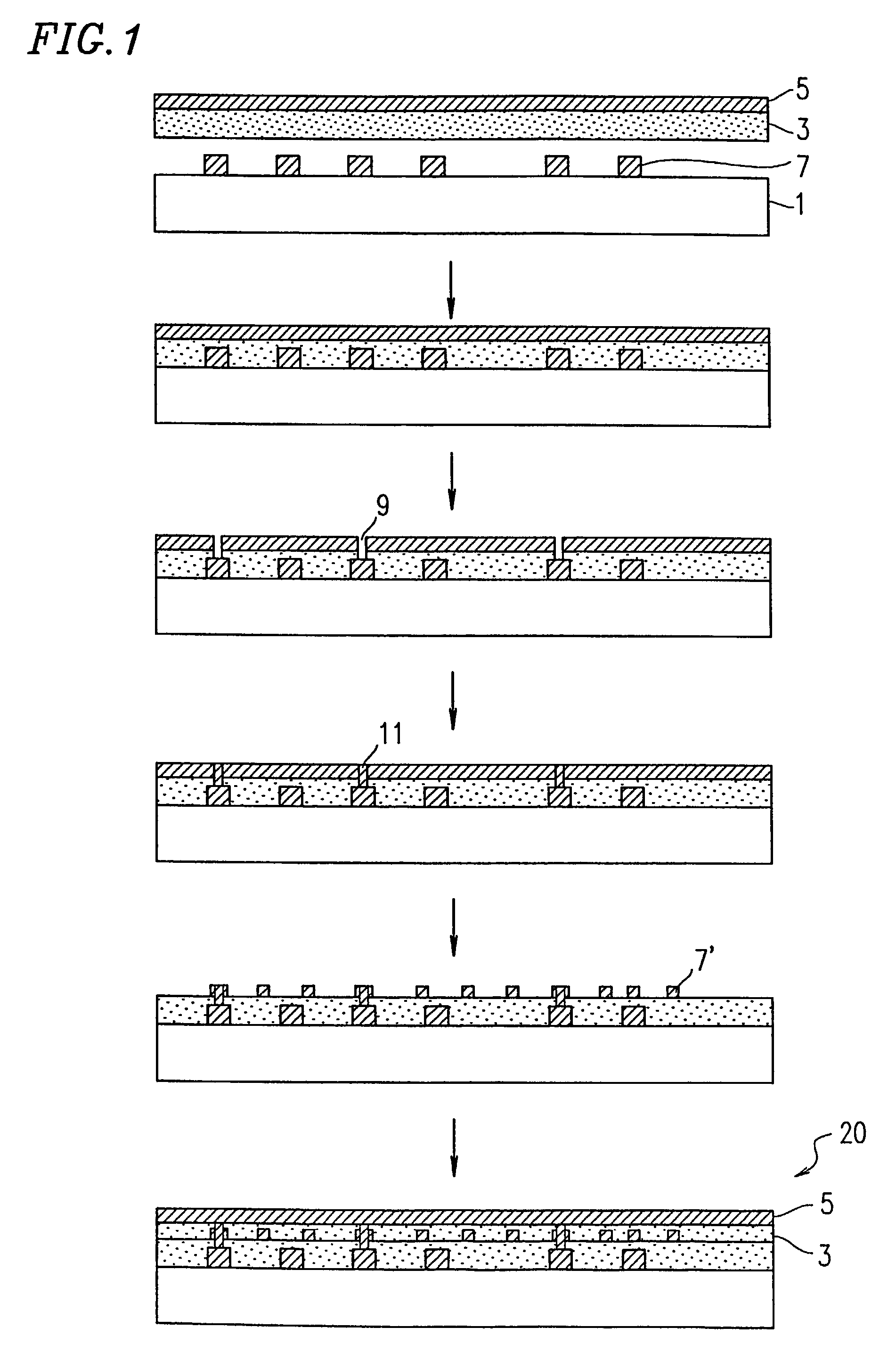Multilayer structure and multilayer wiring board using the same
a multi-layer structure and wiring board technology, applied in the direction of dielectric characteristics, thermoplastic polymer dielectrics, insulating substrate metal adhesion improvement, etc., can solve the problems of lack of rigidity of wiring boards, lack of reliability of packages, and inability to reduce size and weight, etc., to achieve uniform thickness, low coefficient of linear expansion, and high heat resistance
- Summary
- Abstract
- Description
- Claims
- Application Information
AI Technical Summary
Benefits of technology
Problems solved by technology
Method used
Image
Examples
example 1
[0174](1) DMF and p-PDA having an equivalent weight of 1 and ODA having an equivalent weight of 1 were added to a separable flask, followed by stirring well at room temperature until the diamine compound was completely dissolved. Thereafter, the mixture was cooled on ice. TMHQ having an equivalent weight of 1 was added to the mixture, followed by stirring for 40 minutes while cooling. Thereafter, PMDA having an equivalent weight of 1 was dissolved in DMF, and was gradually added to the mixture, followed by stirring for 1 hour while cooling, to obtain a DMF solution of poly(amic acid). It should be noted that the amount of DMF used was equivalent to a monomer feed concentration of 18% by weight of the diamino compound and the aromatic tetracarboxylic acid compound.
[0175]10 g of acetic anhydride and 10 g of isoquinoline were added to 100 g of the above-described poly(amic acid) solution, followed by uniformly stirring. Thereafter, defoaming was performed. The mixture was flow-cast on ...
example 2
[0182]A heat resistant polyimide film having a copper thin film was obtained in the same manner as that of Examples 1(1) and (2), except that a poly(amic acid) solution flow-cast on a glass plate was dried at about 110° C. for about 5 minutes, the resultant poly(amic acid) gel film peeled off the glass plate, and was immersed in dihydroxytitaniumbislactate / 1-butanol solution having a titanium concentration of 400 ppm for 10 seconds, so that excess liquid drops were removed. The resultant polyimide film had a modulus of tensile elasticity of 6 GPa, a water absorption ratio of 1.2%, and a coefficient of linear expansion of 1.0×10−5 / ° C.
[0183]Varnish was prepared in a similar manner to Examples 1(3) and (4) flow-cast onto a surface of the resultant polyimide film, instead of the glass plate, followed by drying at 100° C. for 10 minutes, and then at about 150° C. for about 20 minutes, thereby obtaining a multilayer structure of the present invention comprising an adhesive layer having a...
example 3
[0186]A polyimide resin and a polyimide film were obtained in the same manner as that of Example 2, and a conductor layer was formed in the same manner as that of Example 2, except that a dihydroxytitaniumbislactate / 1-butanol solution having a titanium concentration of 1000 ppm was used. The resultant polyimide film had a modulus of tensile elasticity of 6 GPa, a water absorption ratio of 1.2%, and a coefficient of linear expansion of 1.0×10−5 / ° C. The multilayer structure had a conductor layer having an initial adhesive strength of 8 N / cm, and a satisfactory adhesive strength to a conductor, and is suitable as a material for a multilayer wiring board. Further, the thus-obtained multilayer structure was superimposed on the opposite surfaces of a circuit substrate having a circuit pattern on the opposite surfaces of a polyimide film thereof, where each adhesive layer thereof faces the circuit pattern surface, followed by lamination using a pressing apparatus where conditions for pres...
PUM
| Property | Measurement | Unit |
|---|---|---|
| water absorption ratio | aaaaa | aaaaa |
| dielectric breakdown voltage | aaaaa | aaaaa |
| adhesive strength | aaaaa | aaaaa |
Abstract
Description
Claims
Application Information
 Login to View More
Login to View More - R&D
- Intellectual Property
- Life Sciences
- Materials
- Tech Scout
- Unparalleled Data Quality
- Higher Quality Content
- 60% Fewer Hallucinations
Browse by: Latest US Patents, China's latest patents, Technical Efficacy Thesaurus, Application Domain, Technology Topic, Popular Technical Reports.
© 2025 PatSnap. All rights reserved.Legal|Privacy policy|Modern Slavery Act Transparency Statement|Sitemap|About US| Contact US: help@patsnap.com



